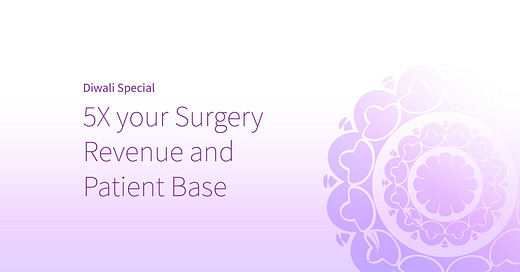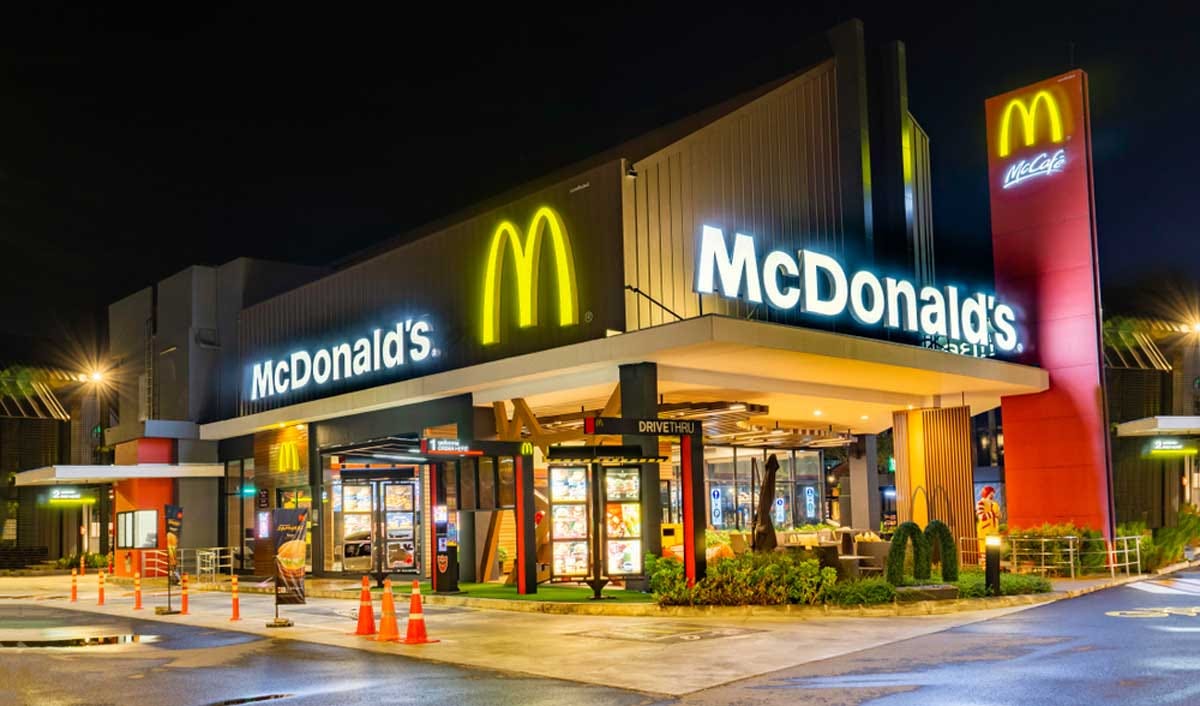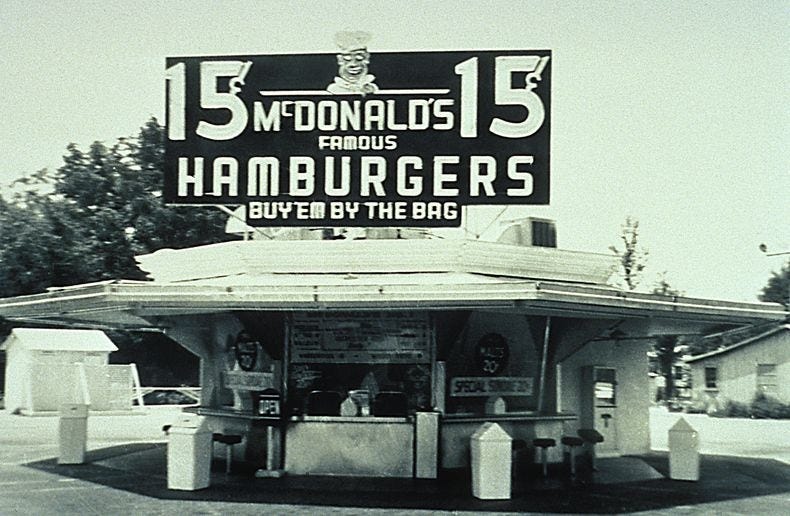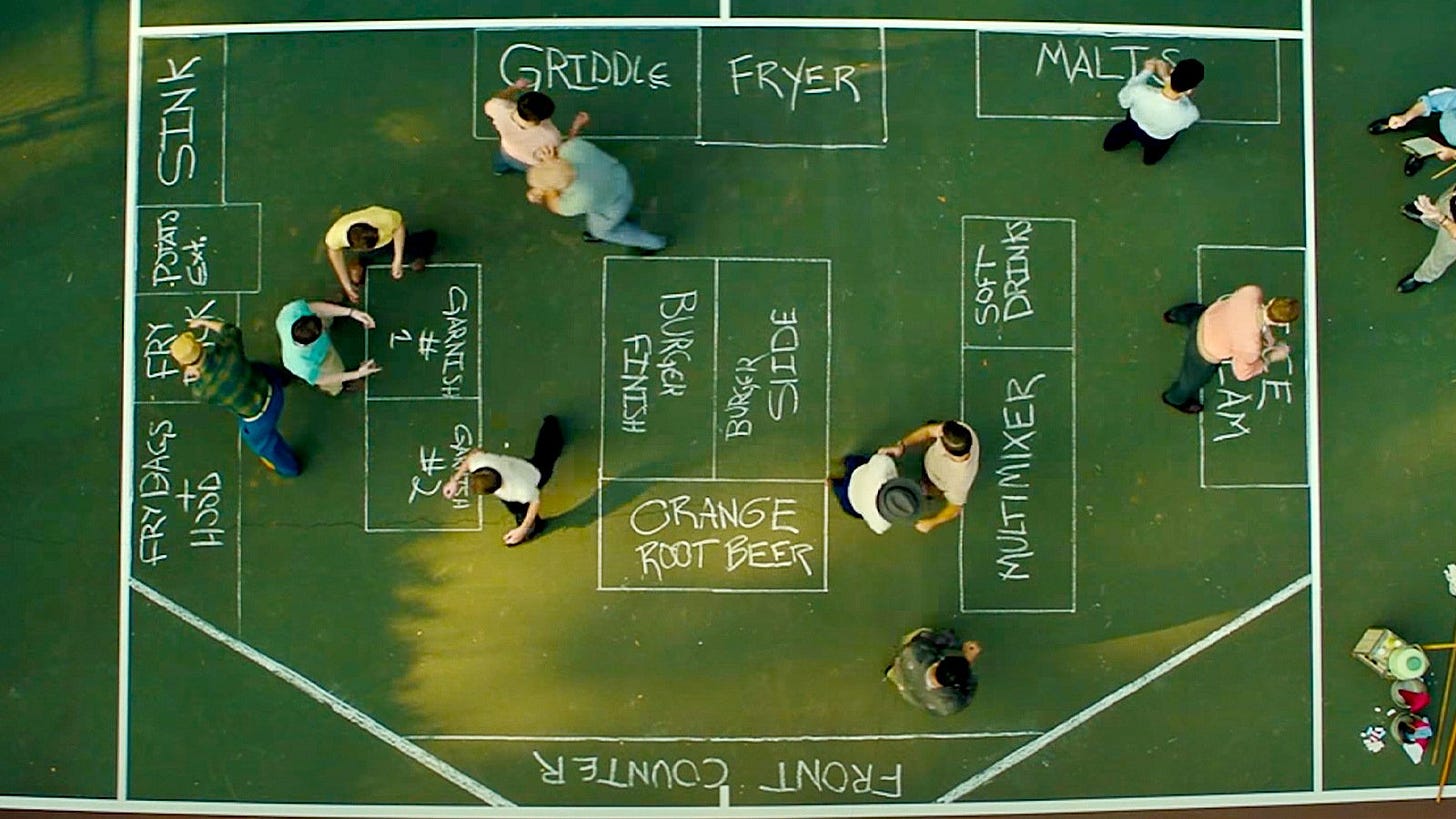Click to 5X your Surgery Revenue and Patient Base
It's Diwali and we're having a lightbulb moment
“What should I do to 5x my patient base?” is a simple, powerful, and effective question. But no-one has a solid answer. Today, we’re going to change that, and much more, including the question.
In today’s edition of Endometriosis Weekly, you shall be given the most important, relevant, and valuable insight you would’ve ever received about building your practice.
This edition will leave you enlightened, it will leave you in tears. By the time you are done reading this, you will look up from the screen, and scream! “I see the light” you will yell! Because you would’ve found an answer you never thought was possible.
Hold my hand, walk with me. Today, we will find wisdom. Today we will find ourselves.
Like every other journey, this one begins by packing and preparing for the trip. Here’s what you need to do. Grab a bag and start throwing these things in
Pack some open-mindedness
Pack your thinking cap - it will get cold along the way
If you have one, pack a thinking coat also
Leave behind your ego and sense of accomplishment, or security will take it away
Leave behind the idea that medicine is a unique profession. It’s not. It’s like any other business, and the same rules help you succeed or fail.
Good. Now you’re ready. The first leg of our journey is a story. The story of McDonald’s.
You know McDonald’s. The fast food chain that you’ve probably been to as a child or have been dragged into by your child. It’s a simple place.
You walk up, there is a predictable menu, predictable serving size, predictable flavours, and predictable offerings. If you’ve been there more than 3 times, you’ve probably even stopped looking at the menu. You just show up, tell your order, make the payment, if you’re like me; refuse to give your phone number, and then move on in life. Your food arrives in a predictable sub-7-minute time. Even the slightest variation in any of these elements causes people great grievance.
A two-minute delay in the order, a non-functional mode of payment, a slightly cold bun, or fries that are not as crisp as you like them. Any one of these is enough to send someone screaming down the ordering aisle.
And McDonalds’ is fine with this. In fact they love it! To understand why, we must go back in time. The open mindedness you packed is about to come handy.
McDonald’s wasn’t always like this. Started by the McDonald brothers, it was first called McDonald’s famous Barbeque. After running it for some time they realised that most of their revenue came from hamburgers. So they promptly renamed themselves as McDonald’s Famous Hamburgers.
A businessman by the name of Ray Kroc once showed up at McDonald’s. The place was nothing like what he had seen before. It was in the middle of a large parking lot. There was no seating. Just a queue of people placing orders. Ray stood in the queue, and when his turn came he asked for a burger and some fries. Paid his bill. And stood on the side. In no time his burger arrived. Ray had never experienced this before. Earlier restaurants would take 10-15 minutes to prepare your order. More if it was a busy day. More so, if the chef wasn’t in a good mood.
By processing an order in less than 2 minutes, and then asking people to eat in their cars, McDonald’s had eliminated the need for an indoor space, air conditioning, service staff all other overheads.
But they could only do this because it took McD less than 2 minutes to make a hamburger.
Unlike traditional restaurants, they didn’t have infinite customizations. There was just the simple hamburger. A standard set of fries. And a limited number of drinks. Ray got curious and walked up to the counter to see what was happening inside.
He was shocked!
While restaurants would have chefs moving with the food from station to station, McD had flipped the script. Only the food moved. The chefs stayed put. Each person was doing just one thing. Frying a patty, putting ketchup, toasting the bun, and so on.
This meant no one spent time changing over. What looks like simple logic today, was incredible genius in 1954.
Ray later went on to become a franchise partner for McDonald’s, bought the company, and heralded the greatest era of standardization known to man.
Do you feel enlightened?
You have to realise that McDonald’s could do what it could not because of the choices it made, but because of the choices it decided not to make.
They said no to variety
They said no to variability
They said no to delays
They said no to customization
They said no to poor-quality
McDonald’s closed more doors than it opened
In a more relevant example, Aravind Eye Car run by Dr. G Venkataswamy or Dr. V as he is popularly known, is a spectacular example of strategic choices that build a system. In 2004 the hospital was doing short of 100,000 surgeries every year. That’s an ASTOUNDING figure by any standard. And it had a waterfall effect
Patients wanted to come to Aravind because they were very cheap. Almost free.
High flow meant high incidences of complicated cases
High complications in cases meant that the best trainee doctors wanted to keep coming to Aravind to learn
This meant that Dr. V could afford to keep the hospital running 7 days a week
Case volume was so high that they started making their own IOLs (Intra Occular Lenses), further driving down the cost of surgery.
This IOL unit then grew to make Lenses for commercial use. Margins here were so high that they paid for and funded further growth.
Had Dr. V chosen to charge patients any higher in the beginning, he would never have reached a point where the lens business would grow to a point where they could start selling the surplus in commercial markets at a great profit.
Look closely. Enlightenment is coming.
Aravind Eye Care is the McDonald’s of hospitals. And I say this with the utmost respect to both places. Besides Dr. V and a few others, hardly any of the doctors at Aravind would stay put. 6-10 months is the average duration a doctor would spend there. Does that mean the surgeries there are below par? Absolutely not. In fact they’re amongst the best.
Every time you visit McDonald’s, you’re never greeted by the same attendant. Attrition there is in months. Does that mean your burger tastes different? No. It tastes exactly like it did the last time. And that’s why you got to McDonald’s.
Aravind simply cannot charge for surgeries, even if they really wanted to. The system wouldn’t allow for it. When the model was first made, that door was closed. Opening it now would mean fewer people show up. Fewer surgeries happen. Fewer doctors are needed. Fewer doctors come. It’s a spiral. There isn’t enough demand to support the lens production. The overhead cost of manufacturing gets too high. That operation has to shut down. Everything crumbles.
Do you see the light? Hold on. We’re getting there.
I’m not saying McDonald’s or Aravind is the only way of doing business. There is another way. A way that involves drastically different choices.
The Other Extreme
Mayflower Women’s Hospital, the birthplace of our careers in women’s health, on the other hand, isn’t a McDonald’s at all. We don’t process our patients fast. There is an inherent waiting time involved. Pre surgery prep is lengthy not just because the practice demands it but because we keep standards of preparedness very high.
Despite doing nearly 3 - 4 deep infiltrating endometriosis surgeries every single day, we can’t even come close to the volume that Aravind has reached. Because we’re simply not in the business of speed.
And therefore, the choices we make are different. The doors we close are different.
We invest in deep patient care. Every aspect of their visit is managed, from symptomatic counselling to surgery planning, all the way to discharge and post-surgery rehab.
We can no longer have post-op infections. It’s unaffordable and unacceptable. So we invest millions into streilization systems across the hospital. Nerve preserving surgeries, conservative procedures all take up more time. This means higher surgeon cost, higher staff cost, higher infrastructure cost. We closed the doors of being low cost. We’re not in the business of being low cost.
Every patient’s experience is different. It is curated, customised, and bespoke almost. Each surgery is different from the last, not just in operation but also in counselling, in testing, in diagnosing, in billing, in medicating. As a result people enjoy an entirely elevate experience of care. That is why Mayflower bears 15-30% above market average in wages to our experts through the entire value chain because it simply isn’t possible for us to operate with any possibility of failure.
But that is a choice. Aravind or Mayflower cannot claim to be a better system than the other. They are both simply a compilation of choices. Choices of the things we have chosen not to do. The doors we’ve closed.
You must now close your own doors
Coming full circle, let’s deliver on the promise we made. The question “What should I do to 5x my revenue” now flips, and becomes, “What should I not do to 5x my revenue?”
Ask yourself what doors you have left open, which of those should you close?
Is your aim high volume? Then you must cut costs. Reduce variety. Focus on one kind of procedure. You have to close the door of being the-everything-doctor
Is your aim totality? Then you must increase costs, invest in technology, acquire the best talent. You have to close the door making money from day 0. It’s going to take time, but it promises to pay off.
Is your aim availability? Then you must establish SOPs, find new models of small units and big units, make sure everyone can reach you in less than 30 minutes. You close the door of having huge high tech hospitals in all places.
Your strategy to grow will be a function of the choices that you make. If you leave the wrong doors open, prosperity will escape.
One door you should never close
It’s innovation. Whether at McDonalds, at Aravind, or at any organization that does well, from a fast food joint to a michellin star restaurant, the one door that is always open in successful organizations, is that of innovation.
McDonald’s innovated in several ways, from creating their own special seed variety for potatoes that give the best fries, to making their own special grade of flour, and tools to fill fries into cardboard containers, they innovated relentlessly. So did Aravind, with technology, patient triage, procedures and more. And I’m glad to say that Mayflower values innovation just as much.
Fun fact: Gujarati New Year falls on this Saturday we NutanVarshAbhinandan to everyone celebrating. We will see you on the other side with more tips, tricks, and enlightenment.
Happy Diwali 🪔 ✨ and see you next week!













Great article